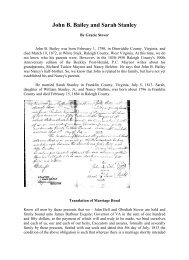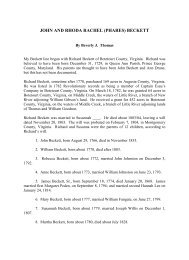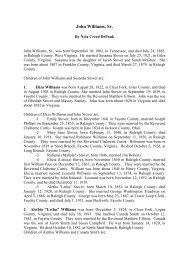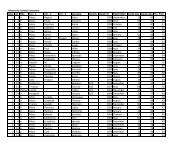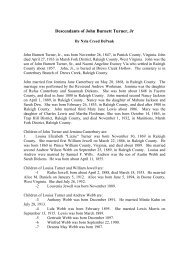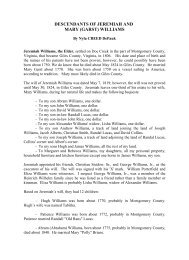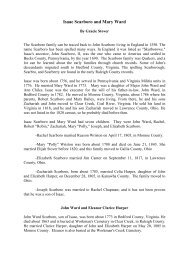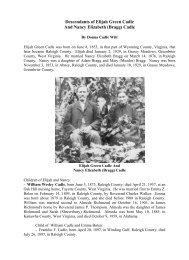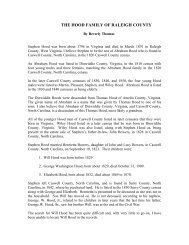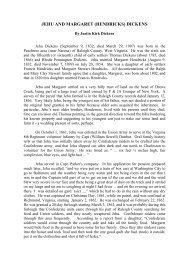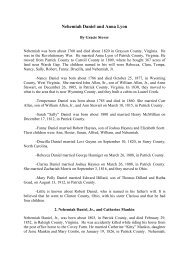THE AMERICAN WEEKLEYS - West Virginia Genealogy
THE AMERICAN WEEKLEYS - West Virginia Genealogy
THE AMERICAN WEEKLEYS - West Virginia Genealogy
You also want an ePaper? Increase the reach of your titles
YUMPU automatically turns print PDFs into web optimized ePapers that Google loves.
<strong>THE</strong> <strong>AMERICAN</strong> <strong>WEEKLEYS</strong>Researched and Written by William C. S. Weekley St John, RN, BA, Akron, Ohio.The first reference of a Weekley in the American colonies connected to our family line is mentioned bythe Weekleys of Tyler County, <strong>West</strong> <strong>Virginia</strong>. In short biographies of various Weekley families we learnabout Thomas Weekley Sr. and his descendents. But here we also learn about his parents, James andSarah Weekley. We know little about James and Sarah as of this writing but hope to learn more infuture. These Weekleys lived in Frederick County, Maryland about ten miles south of the city ofFrederick. We must assume that they were living here before the birth of Thomas in 1754. As of thiswriting we do not know of their other children for sure but one reference lists four children; John, Jacob,Anna, and Thomas “a revolutionary war soldier.”The Maryland Flag: Coat of Arms of the Calverts.The charter for the founding of the Maryland colony was granted in June 1632 to Baron Baltimore,otherwise known as, George Calvert. Baron Baltimore was one of King James’ secretaries of state and aprivy council member. He converted to Catholicism in 1625 and petitioned King Charles I for a settlementwhere Roman Catholics could find refuge from Protestant persecution in England. The first settlementwas in Newfoundland but the harsh climate compelled him to move south, thus Maryland. He did not livelong enough to see the Maryland charter granted. Baltimore’s two sons would fulfill his dream of a freecolony for Catholics. Maryland was unique in that it was made up of free men and as such, each had asay and vote. Perhaps the citizens of Maryland in April of 1649 felt free to rule themselves since Charlesthe First was beheaded in January of that year. For the common Englishman, the world was turnedupside down. The long struggle between an absolute monarchy and constitutional government began toboil after the death of Queen Elizabeth I. Or perhaps they believed that a law insuring the free exerciseof religion would spare their colony a civil war that tore England apart. The Maryland general assembly,half of which was made up of Protestants, on April 21, 1649 passed “An Act Concerning Religion,” thatinsured religious freedom for all people living in Maryland. That same year, Puritans founded the city ofProvidence which is now the modern day city of Annapolis. People from various Christian traditionsmoved to Maryland including Presbyterians, Puritans, Anglicans, Quakers, and Lutherans. The Act didnot prohibit preaching and efforts to persuade others to a particular religious point of view(as long as itwas a Christian point of view), but did provide severe fines for those who would openly criticized orslandered any belief, Christian or non-Christian. The law was very clear:…whatsoever person or persons shall from henceforth upon any occasion of offence otherwise in Areproachful manner or way declare call or denominate any person or persons whatsoever in-Habiting, residing, trafficking, trading or comercing within this province or within any ports, harbors,creeks or havens to the same belonging, an Heretick, Schismatick, Idolator, puritan, IndependentPresbyterian, Antenomian, Barrowist, Roundhead, Seperatist, Popish Priest, Jesuit, Jesuited Papist,Lutheran, Calvenist, Anabaptist, Brownist or any other name of term in a re-Proachful manner relating to matter of Religion shall for every such offence foreit and lose the sum often shillings Sterling or the value thereof to be levied on the goods and chattels of every Such offenderand offender…
And if the person could not pay, they were to be “publickly whipt and imprisoned without bail” until “he,she or they shall satisfy the party so offended or grieved by such reproachful language…” The Actconcludes with a simple yet profound phrase, “<strong>THE</strong> FREEMEN HAVE ASSENTED…” A free peopleexercising self rule had spoken. And freedoms once realized and exercised are difficult to relinquish.By 1654 Oliver Cromwell was firmly in control of England. The Puritans of Maryland feeling giddy asschool girls and drunk on power swept away the Act of Toleration and oppressed Catholics, Jews,Quakers, Atheists and all dissenters. In 1661 Cromwell died and Marylanders repealed the laws of thePuritan regime and reinstated the laws of tolerance where they remained for 31 years.Then a new king and queen came to power in Great Britain in 1688. William and Mary made it a priorityto make Maryland a Crown Colony, reducing the people’s autonomy. Just 43 years after it was enacted,the Act was repealed in 1692 and the Church of England was made the official state church of Maryland.Catholics as well as others would come under heavy scrutiny for years to follow. This constitutionalprinciple of a separated church from a secular state would have to wait 150 years before it slowly becameaccepted practice in America. And only then did the Founding Fathers via the constitution apply thisprinciple to a federal government not to individual states. At the time of the American Revolution and theratifying of the Constitution (1791), every colony had an established state religion except Pennsylvaniaand Rhode Island. Not until the Maryland State Constitution of 1867 would religion cease to be a test forpublic office holders even though provisions were made in 1825 to accommodate non-Christian citizens.And as we have learned in our own time with the Civil Rights Act of 1964 (101 after the EmancipationProclamation of Abraham Lincoln) and the struggle of gay and lesbians for equal civil recognition; merelypassing laws to protect civil liberties does not guarantee acceptance the hearts and minds of the people.It takes generations to overcome ignorance. True tolerance and enlightenment can not be legislated.Behavior can.From 1640 to 1700 Maryland grew from 500 inhabitants to over 40,000. It is not known at this time ifthe Weekleys came to Maryland during this great influx of people. In March of 1732 the proprietor ofMaryland made a proclamation to attract settlers to northern and western areas of the colony. Any personhaving a family that came to Maryland within three years of the proclamation and actually settled on theland could have two hundred acres without payment for 3 years. After 3 years the settler had to pay fourshillings sterling for every hundred acres. A single person, male or female, between the ages of 14 and31 could have 100 acres under the same conditions. They were promised the protection of the Britishgovernment as though they were British, and to be taxed as British subjects. So the people came. Therewere English-speaking people from other parts of Maryland and well as Palatines from Germany. A largeinflux of Scots came from Ulster County, Ireland as well as German settlers from Pennsylvania and partsof <strong>Virginia</strong>.THOMAS JEFFERSON WEEKLEY SR.(I).: The year of Thomas’ birth is in discrepancy. One sourcehas “about 1754” and one states “in 1756” but all agree he was born in colonial Frederick County,Maryland. Of his early childhood we have no information but speculate that he helped out on the familyfarm learning the trade of a farmer. It is believed that his mother died when he was a child. Thomaswas born at the beginning of the French and Indian War (1754-1762) otherwise known as the SevenYears War. The British and the French were at war and their “global” struggle encompassed the NewWorld and Maryland. The French plan was to take possession of the British areas of North American forherself and her allies and divide them up. The French were compelled to war when the Britishgovernment made grants of certain privileges beyond the Allegheny Mountains to the <strong>Virginia</strong> OhioCompany to settle the west in what the French considered their territory. The French who already hadan established colony at New Orleans began to build forts along the Mississippi river valley up to Canadato confine the English settlements to the Atlantic region. The French also had a treaty with the IroquoisIndians, a much feared tribe among all other Indian tribes. The Iroquois were able to intimidate lessertribes into attacking English colonies. The Delaware, Mingo, and Shawnee tribes sided with the French.In the early part of 1754 every Indian suddenly and mysteriously disappeared from Frederick County,Maryland. The emissaries of France had been among the Iroquois reminding them of their treaty and theIroquois rallied their Indian mercenaries. All the communities in western parts of Frederick County cameunder attack. Fort Frederick was erected by Governor Horatio Sharpe in 1756 to protect Maryland’s
settlers and served as a supply base for English campaigns. The Seven Years War ended in 1762 butIndian tribes continued to harass colonists in the western areas of British controlled lands. In May 1763when the Ottawa Indian Chief Pontiac forged a massive Indian uprising, Fort Frederick protected settlersand the militia in western Maryland. Fort Frederick is not in Frederick County but at the narrowest partof Maryland between <strong>West</strong> <strong>Virginia</strong> and Pennsylvania. Thomas grew up in this time of instability. He was9 years old when the final Indian attacks were taking place and the Treaty of Paris was signed ending theSeven Years War. England was given all French lands east of the Mississippi River except NewOrleans. Spain relinquished control of west and east Florida in return for Cuba. Chief Pontiac wasdefeated by the British in August of 1763 near Pittsburgh but small skirmishes continue for years. In thissame year King George III signed The Proclamation of 1763 that prohibited any English settlements westof the Appalachian mountains and required already existing settlements to return east in an attempt toease tensions with Native Americans. Most of the English pioneers stayed put.PRELUDE TO WAR: 1763 - 1775By this time in the English colonies, people are thinking of themselves not as British subjects or Englishbut as a new distinct group of independent people called, Americans. About 40 to 45 percent of thecolonial population supported independence from Britain and were known as Patriots or Whigs. Around15 to 20 percent remained loyal to the British Crown and were called Loyalists or Tories. I have heard itsaid that one third were Patriots, one third were Loyalists and one third waited to see who would win.“No Taxation without Representation:” If movements need a slogan then this one was the rallying cry ofthe colonists against the British Crown and Parliament. The Seven Years War cost the Crown dearly andthe defense of the colonies in America, it was believed, should be paid for by the colonies. A series oftaxes were levied on the goods and services of the colonies. The Sugar Tax in 1763. The Stamp Act ofMarch 1765 imposed the first direct tax on Americans by Parliament which meant that instead of payingtaxes to their local legislatures, the Americans would now be paying taxes directly to England. A yearlater in March of 1766 King George III would repeal the Stamp Act after Benjamin Franklin argued for itsrepeal before the English Parliament and warned of possible revolution if the Stamp Act was enforced bythe British military.The Quartering Act in March of 1765 mandated that Americans supply and quarter British troops in theirprivate homes. In December of that year, British General Thomas Gage asked the New York Assembly tomake colonists comply with the law. Boycotts of British goods spread throughout the colonies andalienated the people and with it, their loyalty to the Crown. In 1766 on the same day the Stamp Act wasrepealed the English Parliament passed the Declaratory Act stating that the British government had totalpower to legislate any laws governing the American colonies in all cases. Again, the British did not learnthe hard lesson that freedoms once exercised can not be revoked. The power struggle continued untilviolence finally erupted. By 1770 the population of the colonies reached 2,210,000. This same year theSons of Liberty in New York scuffled with British soldiers. By December 8, 1774 in Frederick, Marylandan act was passed for the formation of a militia to train for possible revolt. The act stated that companiesshould start drilling and enlisting volunteers between the ages of 16 and 50. The company called theGame Cock was attached to the Flying Camp Battalion, which was organized at Toms Creek Hundred,Maryland in the spring of 1775. Thomas Weekley began training with the First Battalion Flying Camp atthe age of 21. By June of 1775 General Washington appealed to the Continental Congress for moretroops. Maryland responded authorizing the “Maryland Flying Camp” of 3,400 militia troops to fightbeside troops from Delaware and Pennsylvania in the area of operations from Maryland to New York.
Thomas Weekley served June 1, 1776 in the Flying Camp, Maryland under Captain EnosCampbell in General Bell’s Brigade; Colonel Griffith’s regiment and then Colonel Shryhock with MajorMantz. There were four “Flying Camps”; 1) the First Regiment 1776, 2) the Ewing’s, 3) Griffith’s and 4)Richardson’s; all 1776. Thomas Weekley, our forefather, fought in the battle of Harlem Heights on YorkIsland ( now Manhattan) on September 16, 1776 and then in the battle of White Plains, New York onOctober 28, under the command of General George Washington. At White Plains 2000 Americans faced13,000 British and Hessian troops led by the British commander in chief, Sir William Howe. These twobattles ended with the Americans retreating. As winter set in, the British returned to winter quarters butonly after they captured Forts Washington and Lee with 3,000 American troops. This led Thomas Paine,who was with the retreating American army to write, “These are the times that try men’s souls.” TheContinental Army started out 19,000 strong that September. By November that number had dwindled to5,000 battle ready troops. That number would be reduced to 1,400 men after enlistments were up onDecember 1, 1776. Thomas Weekley served his six months and was discharged on December 1, 1776at Philadelphia, Pa., missing the famous capture of Trenton, New Jersey by General Washington onChristmas night by crossing the Delaware River and surprising the Hessian garrison. Thomas Weekleyreturned to Frederick, Maryland, presumably to his parent’s house, where he stayed until January of 1777when he returned to the Continental Army as a substitute for John Thrasher who was a drafted militiaman. Thomas then served three months in the Jerseys(New Jersey) under Captain Thomas Frazier,Major Simpson, Lieutenant-Colonel Luckett, and Colonel B. Johnson at Baskin Ridge, and was thendischarged. Thomas was out of combat for 17 months, missing the September and October battles ofBrandywine and Germantown in 1777 in which the Americans suffered defeats. Thomas also missed theterrible winter spent by Washington and his troops at Valley Forge, New York.A MAP OF <strong>THE</strong> BATTLE DRAWN BY <strong>THE</strong> BRITISH GENERAL STAFF
In the year 1778 Thomas Weekley still lived in the town of Frederick, Maryland and was drafted onSeptember 1, 1778 to serve a three month tour under Captain Jacob Sly, Lieutenant Edward Sellman,Ensign Lindsay Delashmutt, and Lieutenant-Colonel Enos Campbell, the same Colonel Campbell hepreviously served under. He was stationed in White Marsh Creek, Pennsylvania, within about two milesof Germantown, where he was discharged. While in the service he was acquainted with GeneralsWashington, Green, Putnam, Smallwood, and Colonels Gunby and George Stricker of the Army.Thomas was later recruited into the Washington County, Pennsylvania militia in Morgan Township in1782 but the Revolution was over on October 19, 1781 at Yorktown. He was stationed at Fort Jackson onTenmile Creek in Washington County (now in Greene County, PA.) So we know that Thomas was inWashington County, Pa in 1782 and no doubt met the woman who would become his wife, Rachel.Since their first child was born in June 1784 and given the procreative nature of their marriage, we canassume that they were married at least by October 1783. So with the signing of the Treaty of Paris inwhich Great Britain, the mother country, recognized the United States of America, so too did Thomasand Rachel covenant to love each other and start a new family. As the nation grew, so too would theWeekley household.After the Revolution Thomas lived in Washington County, (now Greene Co.) PA. for about 15 years.Thomas Weekley’s name is listed in the 1786 state tax records as being in Cumberland township,Washington Co. Pa. Washington County was split in February 1796 to form Greene County. On June26, 1794, Thomas was granted the sale of a tract of land at the headwaters of Ruff Creek. Thomasmarried Rachel around 1782/83 and by 1794, just 11 years on, they had six sons and one daughter. By1794 Thomas was 40 years old. Their children were:3.1. JAMES WEEKLEY (born June 17, 1784- died 1865)M. ca. 1804 JANE_________(1786-after 1860)4.1 John Weekley b. 1809/1810;d. 1895 farmerM. Elizabeth Underwood5.1 William WeekleyM. Sarah Pratt5.2 Rebecca WeekleyM. Alfred Ferguson5.3 Hannah WeekleyM. Perry Pratt5.4 Leah “Tizzy” WeekleyM. Isaac Weekley5.5 James WeekleyM. Isabelle Weekley5.6 Zane WeekleyM. Susan Vansickle5.7 Emily WeekleyM. John Baker5.8 John WeekleyM. Susan Booner3.2. THOMAS JEFFERSON WEEKLEY Jr.(II) ( January 21,1785 in Washington Co., Pa.-1834)M. ca. 1800 MARY_________(1785- died b/n 1850-1860)4.1 Otho Weekley b. 1810M. Elizabeth Kemp5.1Levi D. Weekley b. July 12, 1833 Tyler Co. d. April 28, 1913Civil War Vet: 10th WV Co.’E’ 1862-1865M. Nancy H. Forester6.16.26.3 Perry Washington Weekley b. Sept 1858
M. Samantha S. Cunningham7.1 Florence Weekley b. May 18847.2 Stella D. Weekley b. Nov. 18857.3 Rosa Weekley b. Feb. 18877.4 Anna B. Weekley b. April 7, 1889 d. Ap 28,19115.2 Mary Ellen WeekleyM. John Francis Stephens5.1 Margaret E. “Maggie” StephensM. Dayton Ed Way5.3 William W. Weekley5.4 Elmore W. Weekley5.5 George W. Weekley5.6 Rachel Jane Weekley5.7 Francis Marion Weekley4.2 Thomas Weekley III b. 18124.3 Levi M. Weekley b. 18144.4 Mary Weekley b. 18164.5 Charlotte Weekley b. 18194.6 James Weekley b. 18204.7 Michal Weekley b. 18214.8 Female child, unknown, b. 1826 d. 18323.3. JACOB WEEKLEY (1787-3.4. RICHARD WEEKLEY( 1788- 1848)M. ca 1806 Prudence Wood (1792-1863)3.5. JOHN WEEKLEY ( February 24, 1790- )M. 1) 1814 ELIZABETH GATRELL (1798-1822)M 2) 1824 SARAH ANN JARRETT (1804-1864)3.6 LEVI WEEKLEY (December 11, 1794- 1834 )M. ca. 1809 MARY JANE BATES5. Samuel WeekleyM.__________?4.1 Silas WeekleyM. Melissa Stull5.1 Emery Weekley3.7. SARAH WEEKLEY (June 26, 1792- )M. 1816 ____________BAKER3.8. MARY WEEKLEY (1797-1875)M. ca. 1825 ROBERT ANDERSON (1805-1884)3.9. SAMUEL WEEKLEY (1801- )M. 1) ca 1826 LAVENA DAVIS (1806-1871)M. 2) 1873 NANCY THOMAS (1828- after 1880)
Thomas Weekley Sr. was a farmer after his military service in the Revolution. After living inGreene/Washington County, Pennsylvania, the family moved to Tyler County, <strong>Virginia</strong> (now <strong>West</strong><strong>Virginia</strong>) in 1798. In 1798 war with France seemed imminent. John Adams was now president andGeorge Washington was appointed to lead the army again. The French Revolution (1789-1799) was notable to maintain control over French privateers in the <strong>West</strong> Indies and they were harassing Americanmerchant ships. This led to a quasi-war with France fought entirely at sea until the French agreed to anhonorable settlement. George Washington would fall ill a year later in mid December from “quinsy” oracute tonsillitis. The former president developed a cold but went riding his horse around Mount Vernon onhis usual rounds. Mr. Washington wrote in his diary on December 13, 1799,“snowing and about three inches deep…wind at northeast and mercury at 30Continuing snowing till one o’clock and about four it became perfectly clear:Wind in the same place but not hard. Mercury at 28 at night.”The former president’s cold worsened through the night and doctors were called. Three doctors attendedthe president and the youngest doctor, Elisha Cullen Dick, made a diagnosis of “a violent inflammationof the membranes of the throat, which it had almost closed, and which if not immediately arrested, wouldresult in death.” Dr. Dick urged a radical new procedure called a tracheotomy that he had learned inScotland at the University of Edinburgh School of Medicine. Dr. Craik and Dr. Brown would not agree tothe procedure, being the two senior physicians present. The president was bled a fourth time at theprotest of the younger doctor. The president gave his secretary, Mr. Lear, final instructions for is burial.The President died at 10 PM on December 14, 1799. His last words were uttered five hours earlier, “Tiswell.”[Reference: George Washington: A Life by Willard Sterne Randall, Galahad Books, 1997]Thomas began to receive his Revolutionary War pension in 1833 in Tyler County. Rachel precededThomas in death on July 24, 1842 at the age of 88 after 59 years of married life. Thomas died thefollowing year on November 27, 1843, at the age of 87, no doubt from a broken heart. Thomas andRachel were married for approximately 58 years when Rachel died. After 58 plus years of marriage andnine children, the year and three months that Thomas outlived Rachel must have been a sad and lonelytime. To lay your head down at night and long for the person you shared your life, must be an ache thatno one, save those who have walked that melancholy path, can understand. I speculate that Thomas Sr.named his first son in honor of his father, James; his second son after himself and the first daughter afterhis mother, Sarah. I have no evidence as to their religious affiliation but we can assume they wereChristian. In the 34 years that he lived in Tyler County he was acquainted with the Rev. John Ripley,Samuel Wheeler, William Delashmutt, and David Hickman.3.2. THOMAS J. WEEKLEY JR. (II)Thomas Weekley Jr. continues our family line. When his father and mother left Pennsylvania inGreene/Washington County in 1798 and moved to <strong>Virginia</strong>, Thomas “Junior” was 13 years old. Thefamily settled at Muddy Creek in the Ellsworth District in Ohio County, <strong>Virginia</strong>: it appears that the entirefamily followed Thomas Sr. and Rachel to <strong>Virginia</strong>. Ohio County comprised the panhandle of modern day<strong>West</strong> <strong>Virginia</strong>. This southern portion of Ohio County, <strong>Virginia</strong>, would later become Tyler County, <strong>West</strong><strong>Virginia</strong> in 1814. When Thomas Jr. was born (1785) the U.S. Constitution was still two years away frombeing written and ratified (1787).National Affairs: On September 17, 1796 George Washington left office and warned his young nation notto get entangled in alliances with other nations. In December of 1796 John Adams was inaugurated asthe second president. Both British and French ships were seizing American cargoes bound for theirenemies’ ports. By March of 1797 the French had plundered 300 American ships. The American navywon several naval battles in the Caribbean and France’s foreign minister, Charles Maurice de Talleyrand,
cried uncle in 1800. By 1800 there were 78,000 people living in the area known today as <strong>West</strong> <strong>Virginia</strong>.The western area of <strong>Virginia</strong> had long felt like the red-headed step child of eastern <strong>Virginia</strong>. Eastern<strong>Virginia</strong>ns were wealth large land owners with slaves and controlled the legislature while the western<strong>Virginia</strong>ns were small land owners, virtually without slaves and suffered from inequitable taxation. Thefirst petition to form their own state came as early as 1776 when the western <strong>Virginia</strong>ns asked theContinental Congress for a separate government. In 1810 western <strong>Virginia</strong> protests unequalrepresentation in the <strong>Virginia</strong> legislature. The <strong>Virginia</strong> counties west of the Allegheny Mountains protestthe constitution, in 1829, that favors the slave-holding counties. By 1830 the Wheeling Gazette proposedthat western counties separate from the east. Abolitionist sentiments had grown in New England sincebefore the Revolution with many of those colonies restricting slavery. In the first half of the 1800’s antislaverymovements grew and the Underground Rail Road began operation. Harsh laws were passed tostem the tide of escaping slaves and helping them reach Canada. Slavery and anti-slavery factionswould soon divide a nation, churches and families as civil war loomed in our future.Thomas Jefferson took office on March 4, 1801 and promptly moved to the center of political opinionpledging, “….a wise and frugal government, which shall restrain men from injuring one another, shallleave them otherwise free to regulate their own pursuits of industry and improvement, and shall not takefrom the mouth of labor the bread it has earned.” Spain had ceded its Louisiana Territory to France in1801 giving Napoleon Bonaparte strategic access and control to New Orleans and the Mississippi River.But Napoleon was preoccupied with conquering Europe and agreed to sell the territory to the Americans.The Senate approved the purchase on October 20, 1803, for $15 million, nearly doubling the size of theUnited States. Ohio became a state in 1803 as well.WAR OF 1812This conflict found its roots after the Revolution. Britain was a super power at the time and harboredseething resentment that their poor colonies in the Americas had bruised their national ego by defeatingthem and establishing their own self-rule government of and by the People. The British refused towithdraw from American territory along the Great Lakes and continued to back Native American tribes onthe frontier who were unwilling to sign commercial agreements favorable to the United States. TheUnited States remained neutral while the French and British fought among themselves and each other inthe French Revolutionary Wars (1792-1802) and the Napoleonic Wars (1803-1815). The USA wanted totrade with both Britain and France but policies from both counties restricted trade. In 1807 when theBritish ship Leopard fired on an American ship Chesapeake, President Thomas Jefferson askedCongress to pass an Embargo Act banning all American ships from foreign trade. This hurt New Englandshipping interests and there was talk of New Englanders seceding from the USA.Napoleon repealed the French decrees in 1810 but the British refused. A new Congress was electedin 1810 and declared war on England June 18, 1812. The British announce two weeks before that itwould revoke its orders but news traveled slowly then and war was on. The Americans thought theycould defeat the English with an early invasion of Canada but all attempts failed in both 1812 and 1813.Oliver Hazard Perry’s ships destroyed the British fleet on Lake Erie September 10, 1813 which force theBritish to retreat from the Detroit area. They were overtaken by General William Henry Harrison anddefeated at the battle of the Thames (Moraviantown.) The great Shawnee chief, Tecumseh, whoharassed the northwestern frontier since 1811 and fought with the British, was killed.In 1814 the British defeated Napoleon at Waterloo and began shifting large numbers of ships andtroops to America. The British planned to invade the USA from Canada down through New York andLake Champlain to separate New England from the south; to take New Orleans and block the Mississippiand invade the Chesapeake Bay area. New England opponents of the war met in the HartfordConvention and discussed separation from the Union but stopped short of that, only suggestingamendments to restrict federal powers. In the late summer of 1814 the British won the Battle ofBladensburg (August 24), marched to Washington and burned the capitol causing then PresidentMadison to flee and burned the White House. The British then attacked Baltimore defenses at FortMcHenry where Francis Scott Key wrote the words to the “Star-Spangled Banner.” From the north, theBritish fought a naval battle against a weak American force led by Captain Thomas MacDonough. TheAmericans won on September 11, 1814, destroying the British fleet and causing them to retreat. This
effectively ended the war as the British sued for peace and the Treaty of Ghent was signed on ChristmasEve. But news of it had not reached New Orleans.The Battle of New Orleans began on December 23rd, just one day before the peace treaty was signed.The British armada of 50 ships transported 10,000 veteran troops from Jamaica. The British Admiral, SirAlexander Cochrane, scattered the makeshift American fleet on Lake Borgne. Communication being whatit was and national pride at stake; each side fought. I will not bore you with the details of the battle butthe Americans won the final battle on January 8, 1815, killing 4,000 British but only losing 8 Americans.Major General Andrew Jackson, “Old Hickory,” was the commanding American officer.The Weekleys I have been able to find that were part of the War of 1812 was a Corporal JosephWeekley. He is listed as an officer under Captain Joseph Jenkinson’s Company, probably from HamiltonCounty, Ohio.THOMAS JEFFERSON WEEKLEY JR. (II) (1785-1834) would marry a woman called, Mary, last nameunknown. Mary was born in 1785 in Pennsylvania and lived into her 60’s; dying sometime between 1850-1860. Mary was found in the 1850 census in the home of her daughter, Michal White. We can onlypresume what might have placed her there: illness, marital separation, estrangement or divorce. Divorcewas not common at this time.The children of Thomas Jr. and Mary were; [I choose to leave the discrepancies between this order andthe dates of the children as I found them in two separate sources. I tend to trust this order and datingfrom the above order and dates.]4.1 THOMAS JEFFERSON WEEKLEY III (November 27,1807 Ohio County, Va.-1879)M. 1831 Valinda Walls (1803- )4.2 MARY WEEKLEY (1810- )M. 1834 Rezin Baker (1798- )4.3 OTHO WEEKLEY (1812-1865)M. ca. 1832 Elizabeth Kemp (1813-1878)4.4 LEVI M. WEEKLEY (1814-1887)M. ca. 1837 Mary Jane Lyons (1819-1897)4.5 CHARLOTTE WEEKLEY (1817- before 1880)M. ca. 1839 James V. Starkey (1819-1899)4.6 MICHAL WEEKLEY (1821- )M. 1842 David White4.7 JAMES WEEKELY (1824- )M. 1844 Phoebe Reed (1823- )4.8 A FEMALE WEEKLEY ( 1826-1832)1834 was a bad year for the Weekley family. Both Thomas Jr. and his brother, Levi, would die in thisyear. The un-named Female Weekley died just two years before that at the age of 5 or 6. Thomas Sr.and Rachel both lived to bury their sons. From what Thomas Jr. and his brother, Levi, died of we do notknow. Perhaps from disease. Flu perhaps. Worldwide influenza epidemics occurred in the followingyears: 1732, 1781, 1802, 1830, 1847, 1857, 1918, and 1968. Pandemics have a history of sweeping the
world in a 2 year period so it could be that the un-named female Weekley might have died from this in1832. And Thomas and Levi two years later.EARLY 1800’SIn the early half of the 1800’s the next Weekley generation would be born that is our line.THOMAS JEFFERSON WEEKLEY IIIThomas J. Weekley III was born in 1807 in Ohio County, <strong>Virginia</strong> (later Tyler, County in 1814). He wouldlive to be 72 years old and father five children with Valinda Walls. Valinda was the daughter of CharlesWalls. Thomas III was a shoemaker and lived in the Morgantown area. He married Valinda Walls ( May20, 1803- ……) on May 19, 1831 who had a son before her marriage to Thomas. His name wasSolomon Walls and was born in 1824. So Solomon was 7 when his mother married Thomas. Thomas isfound in Tyler County in the 1840 census, and then in Monongalia County in the 1850, 1860 and 1870census. In 1880 Valinda is found in the home of her son, Solomon, in Preston County, <strong>West</strong> <strong>Virginia</strong>.The children of Thomas and Valinda were,5.1 REBECCA WEEKLEY ( 1832- )M. ______________?5.2 LEVI WEEKLEY (1833-1905)M. 1859 Melissa Brand (1842-1904)5.3 JAMES K. WEEKLEY (1838-1907) Civil War Vet.M. 1860 Vilinda Wells (1844- 1890)5.4 DELILA ELLEN WEEKLEY (1843-M. James G. Downey (1844-5.5 GEORGE WASHINGTON WEEKLEY (1846-1905)M. <strong>Virginia</strong> J. Cox (1852-******************************************************************************************5.3 JAMES K. WEEKLEY ( 1838-1907)M. Vilinda Jane Wells (1844-d. June 7, 1890) Jan. 19. 1860 in Marion Co.In the Marion County 1880 Federal Census in <strong>West</strong> <strong>Virginia</strong>, James K. Weekley , 43 years old, is listedwith his wife, Vilinda Jane (Wells) Weekley, 36 years of age. James was a “farm hand” and Vilinda was“keeping house.” Vilinda was the daughter of William and Ann Wells from Richtie County. James is listedas a Civil War Vet but not sure where he fought or with whom. Listed with them were ten children;6.1 Stephen Alexander Weekley, age 18. Born September 13, 1861-died March 30, 1936 at EuclidCalhoun Co. 74y 6m 17dM. 1) 1882 Flora A. Stewart (1862-1898)M. 2) Mary “Mollie” Analene Campbell (b. June 2, 1865-d. Feb. 4, 1929)6.2 Charles Jefferson Weekley, age 17 (1863-1929)M. 1886 Samantha Stewart (1872-1929)6.3 Mary Jean Weekley, age 15 (b. March 4,1865-d. May 4, 1929)M. ___________Garrison6.4 Margaret Anna Weekley, age 13, (b. Feb. 1, 1867-d.__________)M. August 27, 1892, Levin Hennen in Marion County, WV.
6.5 Cornelia E. Weekley, age 11, (b. March 22, 1869-d. May 23, 1925)M. March 2, 1889 to Andrew T, Sine (1870-_________)6.6 Emma V. Weekley, age 9, (b. 1873-__________)M. Nov. 21, 1896 to Elmus Wilson (1875-______), Marion County6.7 Edgar Lee Weekley, age 7, (b. March 22, 1873- d. April 25, 1928)6.8 James R. Weekley, age 5, (b. Oct. 12, 1875 in Marion Co.- d.___________)6.9 Franklin E. Weekley, age 3, (b. August 12, 1877 in Marion County, WV-d._____) moved toAthens, Ohio.6.10 Edith D. Weekley, age 1(b. 1879-d. _________)6.11 Male Child Weekley (b. Jan. 2, 1882- d. Jan. 3, 1882)6.1 STEPHEN ALEXANDER WEEKLEY (1861-1936)Stephen was born in 1861, the year of the American Civil War’s beginning. The first shots were heardat Fort Sumter in South Carolina in April, 1861, and Stephen would be born on September 13. Of course,being so young the war would have ended before he would have a recollection of it. But severalWeekleys would fight for and against the Union. In our immediate family there were four who were in the14th W. Va. Infantry Volunteer Regiment. They were Daniel Weekley (1826-1908); Isaiah Weekley(1838-1931); Ethelinda (Weekley) Pratt’s husband, William W. Pratt; and Isabelle (Weekley) Weekley’shusband, James Harrison Weekley, all served for three years from 1862-1865. George Weekley (1842-1926), Isaiah’s half brother, served in Company M, Sixth W. Va. Infantry Volunteer Regiment from 1862-1865.<strong>West</strong> <strong>Virginia</strong> broke from the Commonwealth of <strong>Virginia</strong> when the Civil War started. In the secondWheeling convention from June 11-25, 1861 the western counties refused to secede with <strong>Virginia</strong> andcreated the Restored Government of <strong>Virginia</strong> in Wheeling. On August 20th the Second Wheelingconvention adopts a dismemberment ordinance that provides for the formation of the new state to becalled, Kanawha. In November the convention reconvenes and names the new state, <strong>West</strong> <strong>Virginia</strong>. Theeighteen counties that formed the future state of <strong>West</strong> <strong>Virginia</strong> sided with the Union and contributed32,000 men to the Union forces and 10,000 to the Confederate side. <strong>West</strong> <strong>Virginia</strong> was admitted to theunion provided it amended the state constitution to provide for the gradual emancipation of slavery. OnJune 20th, 1863 <strong>West</strong> <strong>Virginia</strong> was admitted to the union as the 35th state. In 1866 the state constitutiondenied citizenship and suffrage to all persons who had supported the Confederacy.Stephen A. Weekley was born and lived his life in Marion County, <strong>West</strong> <strong>Virginia</strong>. It was there at the ageof 20 that he married Flora A. Stewart on March 23, 1882 and they had six children. Those children were:7.1 Jess J. Weekley or Jesse James Weekley (b. April 13,1883- d. December 1904)Never married and no children7.2 Charles “Charley” Ellsworth Weekley (b. Sept. 6, 1885 - d. April 1, 1967)M. Jessie Siers married on Aug. 14, 1910Children: 8.1 Ronzel Hubert Weekley (b. Dec. 7, 1919-d. May 13, 1999)M. Dorothy “Dot”_________ in 1949, no children.Ronzel worked for PPG in Barberton, Ohio for 19 years. Ronzel wentInto the military two days after Pearl Harbor, on Dec. 9, 1941 thruFort Hayes, Ohio. Truck Driver Light. FS 27 9m 25d. Africa, Sicily,Normandy, Northern France, Ardennes, Rhineland, Central Europe.Good conduct medal, Belgian Fourragere, European-African- MiddleEastern Service Ribbon. Discharged on Oct. 13, 1945
8.2 Charles Dwane Weekley (b. Jan. 12, 1928-d. Oct. 2 1954)26y 8m 20d Laborer, carpenter, worked at PPG was married. Charles was stabbed to death byFloyd MorrisM.1) Shirley Hall9.1 Karey9.2 TinaM. 2) Tammy Birch9.3 Richard Lee Weekley9.4 LisaM. Mark Moore10. Taylor8.3 Booney Ezra Weekley (b Jan. 30,1915-d. Jan. 23, 1968)WWII Vet. Sergeant 988th A. Engineer Sq. 558th A Service Group. Inducted July 10,1941. Fort Thomas, Ky. MechanicAutomotive Wheel Vehicle. FS 6m 21d. Asiatic-Pacific Theater Ribbon. Good Conduct Ribbon.WW II Victory Medal. Discharged: Jan. 18, 1946 Worked at PPG in Barberton, Ohio for 19 years.Died age 51y buried atFairview Cemetery. Lower Nicut W. Va.8.4 ZellaM. Aug. 3, 1935 Sherman Brown8.5 RuthM. ___________Stemple8.6 Edgar WeekleyM. Thelma Jarvis (b. d. Nov. 9,2001)One son: 9.31 Doug Weekley, Doylestown, OhioOne daug. 9.32 Debra Kerr, Mt. Vernon, Ohio7.3 Phillip Weekley (b. March 13, 1887- d. summer 1966)M. Delia Siers on Feb. 26, 1908Children; 8.20 Jeff Weekley8.21 Don Weekley7.4 Anna Weekley (b. January 20, 1889- d. April 2, 1976)M. 1) A. Ernest Cooper married May 19, 1912M. 2) Ward McClain7.5 Viola Elizabeth “Olie”or “Ola” Weekley (b. Oct. 4, 1892- d. Jan. 20, 1973)M. William H. Siers (1881-1968) on April 4, 1909 Calhoun Co. she was 17y whenMarried.7.6 Rose M. Weekley (b. July 7, 1895- d. Feb. 23, 1977) she was 18y when married.M. Dec. 19, 1912 Charles C. Arnold (b. Sept. 15, 1889- d. May 26, 1952)8.41 Icy Arnold (b. d. Nov. 13, 2001)M. John Chenoweth9.41 Bonita Hathaway of Union Grove, Atlanta9.42 Pauline Este of Durham, N.C.8.42 Golda Lawrence of Zanesville, Ohio
Flora Stewart was born in Greene County, Pennsylvania, on May 18, 1862. She died on April 17, 1898 inMarion Co., <strong>West</strong> <strong>Virginia</strong> and is buried at Bee Gum Cemetery, Mannington, WV. The account of herdeath is two fold. One story is that she was caught outside in a rain storm, contracted and died ofpneumonia. She was 35 years old and 10 months. The second story is she died of tuberculosis.Stephen then married Mary A. “Mollie” Campbell ( b. June 2, 1965-d. Feb. 4, 1929)by the 1900 census inMarion County, WV and moved shortly thereafter, in 1901, to Calhoun County, WV where Mary’s fathergave Stephen land as a dowry. This track of land was located on Lower Nicut Run off State Rt. 16, offthe Euclid-Upper Nicut Run. On this land, Stephen built a two story log cabin on field stone and dug awell off the back of the cabin. The cabin and well remain to this day (2006). [ Side note: Lowell Weekleybought the land and cabin after the death of Tusca Weekley and rehabilitated the cabin, madeimprovements to the outside where he and his wife, Janet, retired in the 1990’s.]<strong>THE</strong> CABIN BUILT BY STEPHEN A. WEEKLEY 1902The account of the move to Lower Nicut in Calhoun County from Marion County was written down byFrederick William Weekley, the son of Stephen and Mary Weekley, on December 4, 1975. I shall retellhis story as written down for me in 1975. In the interest of authenticity I have kept the original spellingand phrasing as Fred wrote it, but added punctuation for easier reading. The story goes;“Stephen Weekley moved from Marion Co. with his seven children to Calhoun County in 1901.They moved on road wagons, three of them. My father would always manage some way for motherAnd the four girls to sleep in someones house. The teamesters and the three boys slept under theWagons. It was a hard journey then for there wasn’t much road. John Smith lived on what theyCall Granny She, the old house still stands. He was a find man. Anyway, he had what you wouldCall a log cabin just above his home on the flat. Dad didn’t have anywhere to live till he built aHouse. Mr. Smith told him he could move in the cabin while he built a house. It was only a oneRoom with an attic, we use to call that, where the boys slept. My father built a log house on lore[lower] Nicut. It still stands. My brother lives there. Tusca, which was never merried. I rememberFrom a boy when I ust to come to Minnora to the flour mill. Kerry White owned it then. HomerWitte bought him out. It was fun around 60 years ago. There wasn’t any schoolhouse at NicutWhen my dad moved. All the school they had was in Simon Arnold’s house in what they calledThe parlor. And I believe they had school in George Arnold house one year. Simon Arnold,George Arnold, my dad and probably some more started a fight and got a schoolhouse which isStill standing-the only place us children ever went to school.”After the move to Calhoun County the family continued to grow. Mary “Mollie” A. Campbell and StephenA. Weekley would have three children and they are;
7.7 Luella Weekley (b. August 3, 1900- d. Oct. 28, 1918)Luella never married and died in the Flu Epidemic of 1918.7.8 Fredrick William Weekley (b. August 10, 1904 Calhoun Co.- died January 14, 1988)Buried at the Minnora Cemetery, Rt 16. Calhoun Co. WVM. 1) Lear Parsons d/o Bailey and Nannie (Bailey) Parsons. Born Nov. 21, 1908- d.March 4, 2004) buried at Minnora Cemetery next to her parents.Married May 17,1925. She was 17 and he was 21.Lear divorced Fred in 1955.M. 2) Opal (Knotts) Cottrell d/o Charles C. and Ettie (Duffield) Knotts(b. Sept. 6, 1916 Walnut, WV. - July 2, 2007)Divorced her first husband, Ville “Vonnie” CottrellMarried Fred on Nov. 11, 1956The children of Fredrick William Weekley and Lear Parsons Weekley: Glenna, Paul, Lowell, Loy, William,Sharon and Carroll.LEAR PARSONS WEEKLEY, 1967
Calhoun Chronicle" – 11 Mar 2004LEAR WEEKLEYLear Parsons Weekley, 95, died Friday, Mar. 5, 2004.She was the daughter of the late Bailey and Nanny Parsons. She lived in Calhoun County until 1955, thenresided in Akron, Ohio. She retired from Akron City Hospital in 1980. She was a member of Order ofEastern Star.Surviving are four sons, Paul Weekley of Knoxville, Tenn., Lowell Weekley of Nicut, Bill Weekley ofWooster, Ohio, and Carroll Weekley of Parkersburg; one daughter, Sharon Hill of Lineboro, Md.;numerous grandchildren, great-grandchildren and great-great-grandchildren; and one sister, Lucy Baileyof Akron.Services were held at Stump Funeral Home, Arnoldsburg, with Rev. Darrell Mollohan officiating. Burialwas in Minnora Cemetery.Lear’s parents, Bailey and Nannie Parsons, in 1961 at their home in Chloe, <strong>West</strong> <strong>Virginia</strong>




